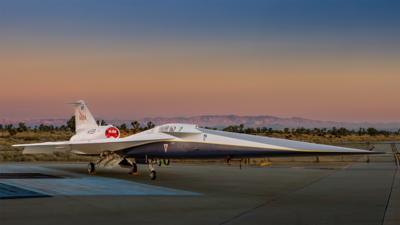Mon, Jan 15, 2024
New Supersonic Prototype Aims to Soften the Blow When Going Beyond Mach 1
No more CGI for the next-gen x-plane from NASA and Lockheed Martin now that the duo has finally debuted the quiet supersonic aircraft live in the metal.

The X-59 Quesst aircraft is a demonstrator to bear out the possibility of supersonic flight without the sonic booms. If successful, the concept will revolutionize public air travel with a whole new niche of high-flying, fast-moving, supersonic aircraft. The Concorde took a swing at the supersonic passenger craft idea, but it ultimately died a slow, expensive market death as its destinations limited its performance to reduce noise on the ground. That apparently ended supersonic pax carriage for good, but new money, new ideas, and fresh materials lie ready and waiting to take another crack at the market.
“This is a major accomplishment made possible only through the hard work and ingenuity from NASA and the entire X-59 team,” said NASA Deputy Administrator Pam Melroy. “In just a few short years we’ve gone from an ambitious concept to reality. NASA’s X-59 will help change the way we travel, bringing us closer together in much less time.”
Melroy was joined by brass from Lockheed and NASA at a ceremony revealing the Quesst demonstrator at the former's Skunk Works facility in Palmdale, California. The aircraft, if successful, won't necessarily be completely free of sonic booms, however. NASA wants to reduce the effect of the supersonic crack with sculpting, shaping, and materials placement that will slough off and delay the transition to supersonic along the body of the aircraft. If successful, the Quesst demonstrator will hit its supersonic cruise of 925 mph or 1.4 mach with a quiet "thump" instead of a loud "boom".
“It’s thrilling to consider the level of ambition behind Quesst and its potential benefits,” said Bob Pearce, associate administrator for aeronautics research at NASA Headquarters in Washington. “NASA will share the data and technology we generate from this one-of-a-kind mission with regulators and with industry. By demonstrating the possibility of quiet commercial supersonic travel over land, we seek to open new commercial markets for U.S. companies and benefit travelers around the world.”
More News
Its Offerings Are Lighter, Cleaner, and Now Pushing Past 1,000nm on SAF Jet Fuel DeltaHawk’s diesel-powered aircraft lineup has seen incredible upgrades over the last few yea>[...]
The Airplane Experienced A Total Loss Of Engine Power On December 3, 2025, about 1600 central standard time, a Mooney Aircraft Corp. M20K, N57229, was substantially damaged when it>[...]
Make Sure You NEVER Miss A New Story From Aero-News Network Do you ever feel like you never see posts from a certain person or page on Facebook or Instagram? Here’s how you c>[...]
Aero Linx: European Society of Aerospace Medicine (ESAM) As a pan-European, independent forum, it works to promote the safety and health of all persons involved in aviation and spa>[...]
“We are excited to see Wisk achieve this milestone, and I’m so proud of the team that made it possible. The team at Wisk has built advanced technologies across flight c>[...]
 Aero-TV: DeltaHawks Diesel Power Steps Into the Spotlight
Aero-TV: DeltaHawks Diesel Power Steps Into the Spotlight NTSB Prelim: Mooney Aircraft Corp. M20K
NTSB Prelim: Mooney Aircraft Corp. M20K ANN FAQ: Turn On Post Notifications
ANN FAQ: Turn On Post Notifications ANN's Daily Aero-Linx (12.20.25)
ANN's Daily Aero-Linx (12.20.25) Aero-News: Quote of the Day (12.20.25)
Aero-News: Quote of the Day (12.20.25)



